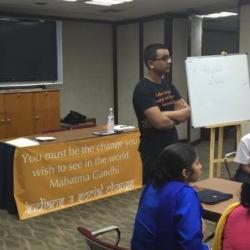To Om Or Not To Om: The Controversy Over Yoga in the United States

Background
Yoga is a growing activity in the United States with more and more individuals taking part in it every year. Largely, the new wave of yogis is composed of non-Hindu’s who want to practice Yoga for the physical and mental health benefits. There is a large controversy, however, over the intersection between faith and yoga for non-Hindus. Schools in some regions of the United States opposed supporting yoga programs in the school because of its religious background and individuals grapple with this issue on a personal level, as discussed in this BBC Article.
The Problem
There is certainly a link between the Yoga and Hinduism, in that Yoga is used to describe a wide range of activities Hindus should conduct (including everything from working, devotion, learning, to the physical type that is practiced by Westerners). There is even further division between the latter into yoga that is practiced with the meditational and spiritual aspects and then yoga that is solely practiced for the cardiovascular and musculoskeletal benefits.
However, these criticisms are not grounded in much fact because the way Yoga is practiced in the United States by the mainstream community of Yogis is largely detached from all of its spiritual and religious connections, and solely done so for the benefits to the body. This is evident in many ways from the abandonment of the use of Shlokas, mantras, and the lack of restricting certain poses to certain times of the day. People engage in the activity like in any other sport by taking classes (including “Yoga Bootcamps”), training on their own, competing, and buying luxury apparel.
Other Countries
Some countries have dealt with the issue by encouraging the presence of classes that don’t discuss the spirituality at all (or use religious remnants such as the syllable Om, considered to be the primordial sound by Hindus and Buddhists). Iran is one such example that has allowed “the Sport of Yoga” to prosper without causing problems with the conservative theocracy that is in power. Malaysia has banned the use of chanting but allows the physical aspects to be taught.
Although this type of strict banning is contrary to good pedagogical standards and lacking cultural appreciation, it proves that Yoga can be practiced without the spiritual benefits.
Solution
It is important to educate people about the differences in practice and meaning between all the forms of yoga practiced by Hindus and the singular, physical-goal oriented yoga practiced in the United States. This burden falls largely on places that offer Yoga classes, sell apparel, and other centers of Yoga in the United States. If yoga is to flourish further and access a greater market (and thus improve overall health), it is important for those establishments to make clear that the Yogic activities they are offering do not require one to abandon their faith or take on Hinduism. It needs to be made clearer that even though Hinduism may have given the world Yoga, taking a Morning Yoga Class does not make one a Hindu.
Conclusion
Making these distinctions will allow a practice that is good for the mental and physical well-being to be practiced without causing any problems for people of other faiths. However, it should also be noted that given that Yoga carries with it a large history, perhaps encouraging “western Yogis” to engage in the culture from which they are borrowing an activity would be beneficial. For example, the “rebranding” of the poses is problematic, because it abandons an important part of the background, in favor of extreme appeasement. It is better to encourage people to practice Yoga as a physical activity and learn about the background, without having the same motives in practicing it as encouraged by the religion. This does not require taking part in beliefs or actions that violate one’s faith, but education about where certain practices came from and how they are practiced in modern India should be encouraged to create a true appreciation and understanding of the Art/Sport/Ritual of Yoga.





